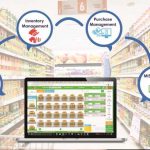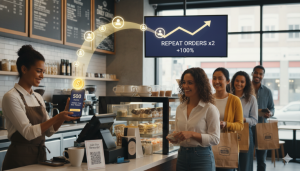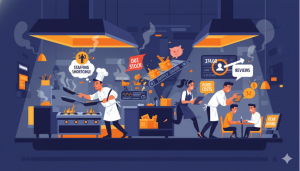Consumers nowadays want next-day, if not same-day deliveries. Businesses and retailers are running around like headless chickens trying to keep up with the demands of today’s customers. Micro fulfillment centers (MFCs) are one solution that retailers have come up with to manage their customers’ needs.
Micro fulfillment centers utilize small and automated storage units close to end-consumers to achieve cost savings and improve delivery times.
MFCs require two key components to perform successfully. These include having a robust enterprise and logistics management system, which processes online orders, and having physical infrastructure for inventory.
Micro fulfillment centers, also known as dark stores, can cover anywhere from 3,000 to 10,000 square feet of area and can either be standalone facilities or be integrated with stores.
The introduction of MFCs marks the start of a new era. However, this new age does not surprise retailers as new technology continuously alters customer expectations and landscapes.
What Is A Micro Fulfillment Center?
Micro fulfillment centers are redefining the last mile by providing a more efficient, localized way to store and distribute goods. Unlike traditional fulfillment centers, which are large and centralized, micro fulfillment centers are smaller and located closer to customers, often in urban areas. It allows for faster shipping times and a more personalized customer experience.
Micro fulfillment centers use cutting-edge technology to automate many tasks associated with order fulfillment, including picking, packing, and shipping. It allows them to operate with fewer employees and lower overhead costs than traditional warehouses. As a result, micro fulfillment centers can offer competitive prices and shorter delivery times than their larger counterparts.
What Is The Micro Fulfillment Model?
The micro fulfillment model is becoming increasingly popular as retailers look for ways to improve their last mile operations. Micro fulfillment centers may grow at a compound annual rate of 30% over the next five years.
If you’re considering opening a micro fulfillment center, there are a few things you need to know. Here’s everything you need to know about micro fulfillment centers, including what they are, how they work, and the benefits they offer.
A micro fulfillment center is a small-scale warehouse that stores and distributes goods. Micro fulfillment centers are typically present in urban areas, which allows them to be closer to customers and provide faster shipping times.
Micro fulfillment centers use cutting-edge technology to automate many tasks associated with order fulfillment, including picking, packing, and shipping. It allows micro fulfillment centers to operate with fewer employees and lower overhead costs than traditional warehouses.
What Is The Difference Between A Distribution Center And A Fulfillment Center?
A micro fulfillment center is a type of distribution center. Distribution centers are more giant warehouses that store goods and distribute them to retailers. Fulfillment centers are smaller warehouses that focus on fulfilling online orders.
What Is The Best Fulfillment Center?
There is no one-size-fits-all answer to this question. The best fulfillment center for your business will depend on your specific needs and objectives for e-commerce you Amazon Multi-Channel Fulfillment is the biggest player.
What Are The Benefits Of Micro Fulfillment?
Micro fulfillment centers offer several benefits, including shorter delivery times, lower costs and a more personalized customer experience.
What Are The Disadvantages Of Micro Fulfillment?
The main disadvantage of micro fulfillment is that it requires a significant upfront investment. In addition, micro fulfillment centers can be challenging to scale due to their small size and location-specific nature.
What Is Micro Fulfillment Technology?
Micro fulfillment technology refers to the automation systems that work in micro fulfillment centers. These systems include robots, conveyor belts, and software to pick, pack, and ship orders.
What Are Micro Fulfillment Center Robots?
Micro fulfillment center robots help to automate the tasks of picking, packing, and shipping orders. These robots can operate 24 hours a day and do not require breaks or vacations. As a result, micro fulfillment centers can fulfill more orders with fewer employees.
Suppliers like Standard Bots have revolutionized the types of hardware that can be integrated as part of MFCs. Robotic arms that can pick and pack products while working within limited spaces, while also having the versatility to take on all sorts of other tasks, are a boon. In addition to being tireless, they remove the need for humans to handle jobs that can be at once dull and dangerous.
What Is Micro Fulfillment Software?
Micro fulfillment software helps to manage the operations of micro fulfillment centers. This software typically includes order management, inventory management, and shipping capabilities. Micro fulfillment software often integrates with e-commerce platforms to streamline the order fulfillment process.
Now let’s look at the need of having Micro fulfillment centers;
Need for highly efficient shipping and deliveries:
Small-scale and highly automated fulfillment centers offer grocery and e-commerce retailers opportunities to scale their operations and logistics at their own pace. Such fulfillment centers enable retailers to be close to customers and allow for curbside pickups or home deliveries if enough demand is expected.
With shipping and delivery evolving into a crucial battleground for e-commerce retailers and online merchants, it is imperative to achieve high standards of logistics processes for gaining and retaining customers. While two-day deliveries were once considered a luxury, it is now an industry norm being taken over by same-day and even same-hour deliveries.
Customer expectations are higher than ever, with no room for new and small retailers to rely on outdated warehousing and logistics methodologies. This can be seen from the ever-increasing investments in shipping infrastructure, new technology, and the growth seen by e-commerce retailers like Amazon and Walmart.
Retailers often face challenges in consumer behavior and expectations which can cause innumerable complications for their business; however, with on-the-ball thinking and agile solutions, they can meet these challenges head-on.
By accepting the new automated and robotic MFCs, retailers don’t have to worry that this solution will become redundant as the industry evolves with the consumers’ wants and needs. This open-minded approach allows businesses to lead the old and archaic practices in the dust and flourish as new technologies emerge.
Retailers are confident that these new robotics solutions will help reduce inefficiencies and improve their bottom line. Research shows that last-mile deliveries account for 41% of a product’s total supply chain costs.
Micro fulfillment centers make last-mile deliveries shorter, which results in them being less expensive, allowing businesses to save significant amounts of money, and keeping customers happy with speedy on-time deliveries.
[INSERT_ELEMENTOR id=”10819″]
Micro fulfillment centers to improve delivery speed and efficiency:
MFC’s mainly enable grocery delivery and e-commerce stores to significantly reduce pickup and last-mile delivery timelines, allowing them to deliver same day or even same hour. MFC implementation can also be fairly simple, allowing such solutions to be implemented anywhere, even where real estate space or cost constraints might exist.
With a rapidly changing retail landscape driven by growing online sales and e-commerce, customers increasingly expect deliveries to be fast and efficient. Changes in customer demands and the development of new technology result in the transformation of supermarkets enabled through micro fulfillment centers. This will result in a seamless omnichannel experience for customers across brick-and-mortar and online stores.
Omnichannel experience allows customers to buy products from businesses in one place and makes sure delivery requests can be made at any point (physically or online). To ensure seamless fulfillment of such requests, retailers use MFCs as an agile solution to all sorts of online retail platforms, including brick-and-mortar stores, websites, e-commerce platforms like Shopify, and social media pages.
Key benefits of investing in MFCs:
The efficiency of retailers increases by the strategic placement of MFCs in large cities. Businesses track down information on where their customers live to understand the orders of their MFCs for best outcomes. To increase their fulfillment capacity, companies can have their micro-fulfillment centers as standalone centers or built next to or inside any existing location.
Below are some of the critical advantages for companies to invest in micro fulfillment centers.
- Automated packaging
Automated MFCs allow physical and online retailers to move their fulfillment centers closer to their customers anywhere within the city, which helps reduce delivery costs and decreases the delivery time. Automation in micro fulfillment centers makes last-mile delivery processes (the picking, packing, and transporting) much easier and faster. For example, if a typical warehouse or fulfillment center processes 60 orders per hour with manual labor, and automated MFC can probably complete 600 orders per hour.
- Inventory optimization
Given the small size of MFCs, they allow for inventory optimization and the use of a just-in-time model. This is driven by specialized inventory held according to local demand and requirements, allowing for efficient utilization of available resources and space. As a result, retailers are able to start selling without needing to hold large levels of inventory and tying up all of their working capital in inventory and payables.
Moreover, by using warehouse automation in MFCs, retailers can further improve their operational efficiency. As a result, they are not only able to hold larger inventories but also offer a wide selection of products. Existing retailers are able to expand into newer markets quickly and add unique and new product lines, as a result giving a significant boost to their sales.
- Responsive Manufacturing
Another key benefit of MFC’s relates to the improvement seen in speed and responsiveness of manufacturing capabilities for small and medium-sized businesses. Through close proximity to end customers, MFCs are able to fulfill orders in a much quicker manner and accelerate their production and inventory cycles.
Due to limited shelf space, businesses become more competitive and allow different stores to carry a more niche inventory that their competitors ignore. This leads to an increase in manufacturing, newer product lines, and a rise in their revenue streams.
- Lower Operating Costs
Another significant key advantage for businesses to invest in micro-fulfillment centers is that they are also less expensive to run, along with being faster than regular warehouses. According to researchers, the upfront investment in MFCs might be a bit steep, but they promise a payback period of only 2-3 years.
Once a business has an MFC up and running, it can expect a vast decrease in its operating cost. Due to the warehouse automation technology, the operation cost of MFCs is cut into almost half of a normal fulfillment center. Online retailers benefit hugely from MFC technology as they can fulfill orders faster while cutting the cost per order by more than 50%.
- Improved Workplace Safety
MFCs, with their automated technology, can ensure the safety of their laborers as all the dangerous tasks can be delegated to robots and other autonomous equipment. For example, you can avoid picking items from a higher shelf, carrying heavy boxes and crates, or working close to heavy machinery with MFC technology.
Picking robots help prevent accidents like carrying heavy crates, getting strains or falling from heights, and being struck by heavy machinery and equipment.
How MFCs Impact Last Mile Supply and Logistics
One of the most important aspects of micro fulfillment centers is their location. Decreasing delivery times from the MFCs to the consumers depends all on how strategically businesses plant their MFCs to their consumers’ vicinity. As long as the e-commerce and last-mile logistics are being efficiently optimized, the centers themselves can be located anywhere in the city or its outskirts.
Customers demand same-day delivery services of online purchases due to the rapid growth in technology and quick commerce. Consumers now demand and expect fast deliveries of whatever they purchase online.
Last-mile logistics is rapidly becoming the battlefield on which retailers try to acquire advantage of other businesses and retailers. These businesses understand that MFCs hold power to change the entire last-mile delivery landscape.
Companies can now cut their costs massively by building MFCs near or in highly populated areas. Doing this will increase customer satisfaction and reduce the warehouse-to-ship-to-door distance and save on labor costs. Conquering the last mile and achieving customer satisfaction simultaneously is now a goal many retailers find attainable.
[INSERT_ELEMENTOR id=”10819″]
A modular solution for a variety of applications
Automated micro-fulfillment centers are the perfect answers that smaller businesses are looking for. Along with general merchandise retailers in POD and other niches, non-retailers, like manufacturers and distributors, can now use the MFCs’ automated technology.
In the post-COVID-19 era, as e-grocery services become more and more popular, micro-fulfillment centers provide grocers with fulfillment centers closer to consumers for quick pick up or home delivery.
MFCs agile solution is perfect for e-grocers with no physical retail stores serving as fulfillment hubs. It allows them to store two five days’ worth of grocery inventory.
It usually takes about one hour to pick up an e-grocery order, making the segment a costly burden for grocers. However, micro fulfillment centers shorten the grocery pickup time to about six minutes. Just like retail micro-fulfillment centers, grocery micro fulfillment centers too can be installed in an already existing supermarkets’ setup. Leading to a hyperlocal function and reducing the cost of last-mile delivery.
How Blink’s Automated software enables businesses for quick commerce
Blink is a quick-commerce enablement software that allows multi-location businesses and consumer brands to implement same-day deliveries. Blink fits the MFC model perfectly, equipping businesses with multi-location fulfillment capabilities.
Blink as a Fleet Management Solution
- Automated Route Optimization
Blinks Fleet Management Platform provides delivery route optimization, reducing delivery time by allowing you to choose your delivery zones. - Synced Rider Activity
Blinks automated software provides real-time tracking of your deliveries by helping you track your driver through advanced GPS technology. - Hub Delivery Model
Blinks fleet management platform lets you assign riders to geofenced localities to pick up orders from your customer’s closest facilities for fast deliveries. - Proof Of Delivery
Check your rider’s attendance, quickly identify the quickest routes and make sure everyone stays accountable and traceable through Blink’s fleet management platform.
[INSERT_ELEMENTOR id=”10819″]
Conclusion
MFCs are, undoubtedly, becoming an essential component of the supply chain in the world of quick commerce. They hold much promise for retailers by shortening their last miles, reducing delivery costs, and providing customers with instant gratification.
Blink helps streamline delivery operations and allows businesses to deliver to the last mile and enhance customer satisfaction effectively. This is the agile MFC solution software your business has been looking for.
Related Articles:
 7 Best Grocery Delivery Software To Use In 2023
7 Best Grocery Delivery Software To Use In 2023
 Blink vs Growcer: Which online supermarket platform is most suited for your business?
Blink vs Growcer: Which online supermarket platform is most suited for your business?
 13 Best Supermarket Software For Businesses In 2023
13 Best Supermarket Software For Businesses In 2023
 أفضل 4 برامج لإعداد نظام بقالة أون لاين وإدارته في 2022
أفضل 4 برامج لإعداد نظام بقالة أون لاين وإدارته في 2022
 5 Best WooCommerce Alternatives for Your Food Delivery Business
5 Best WooCommerce Alternatives for Your Food Delivery Business









